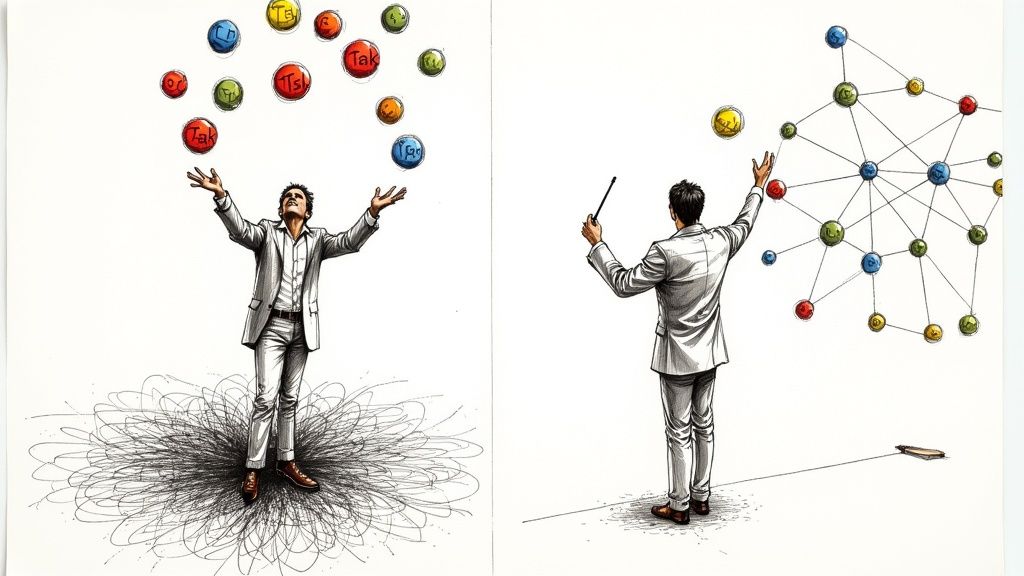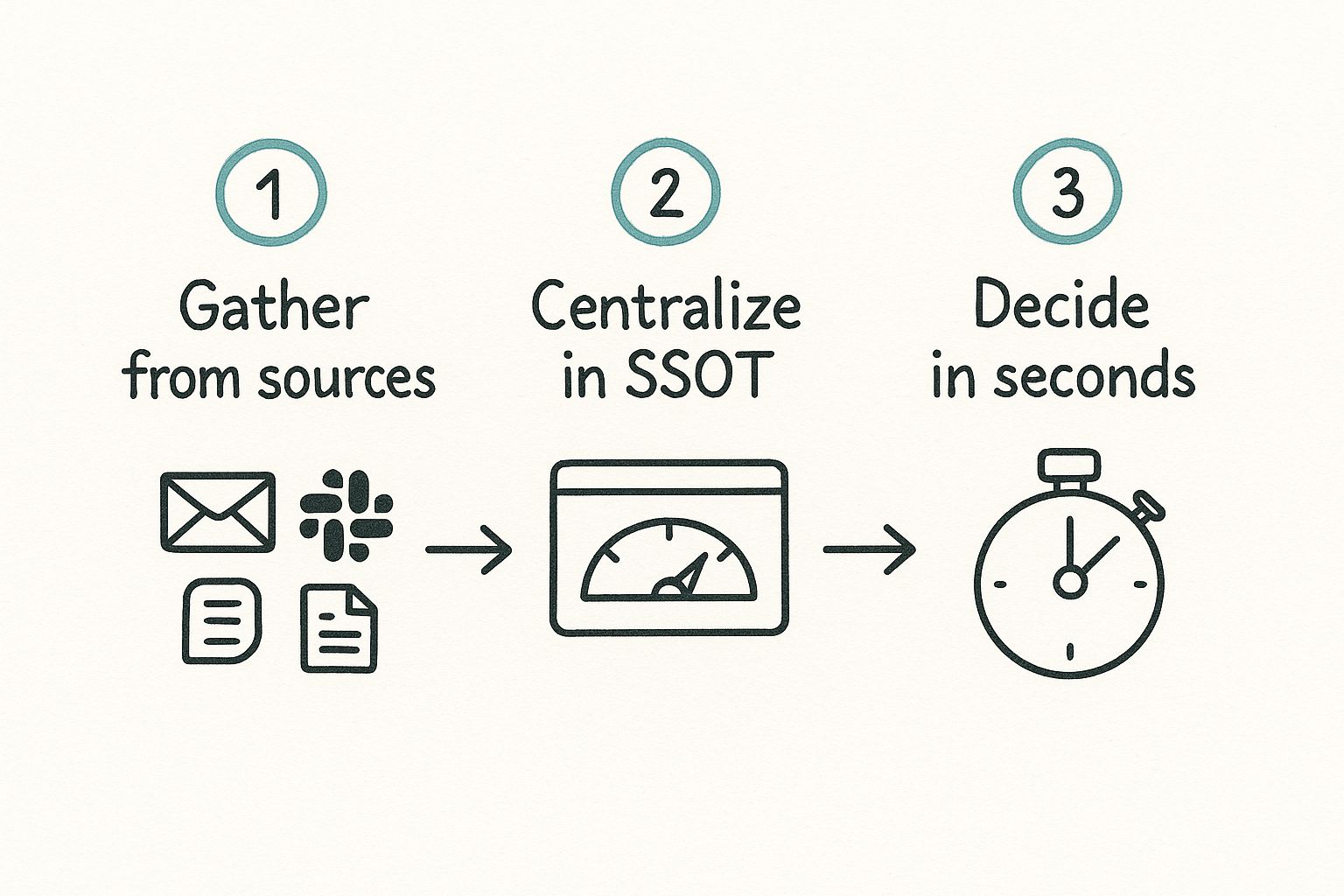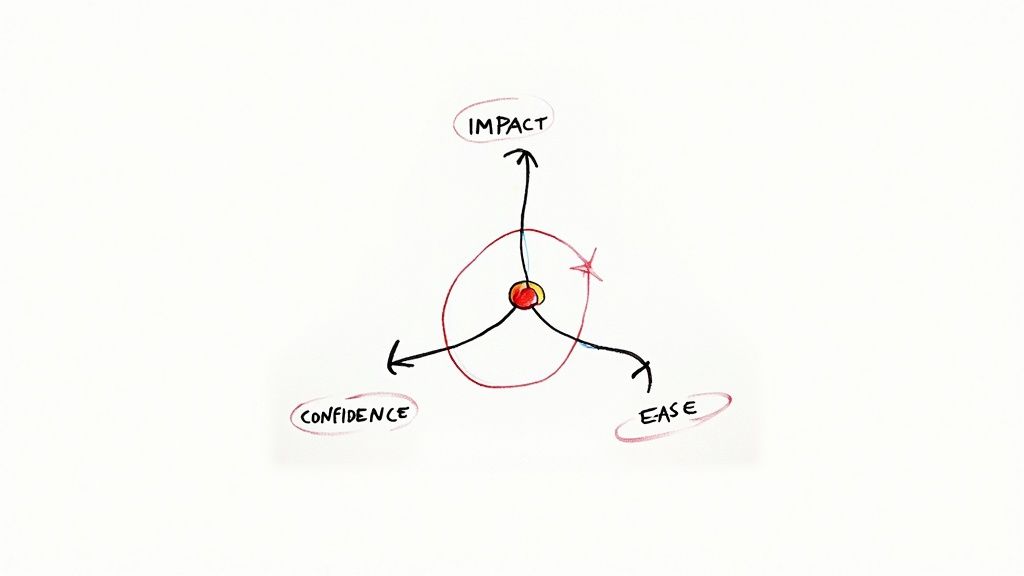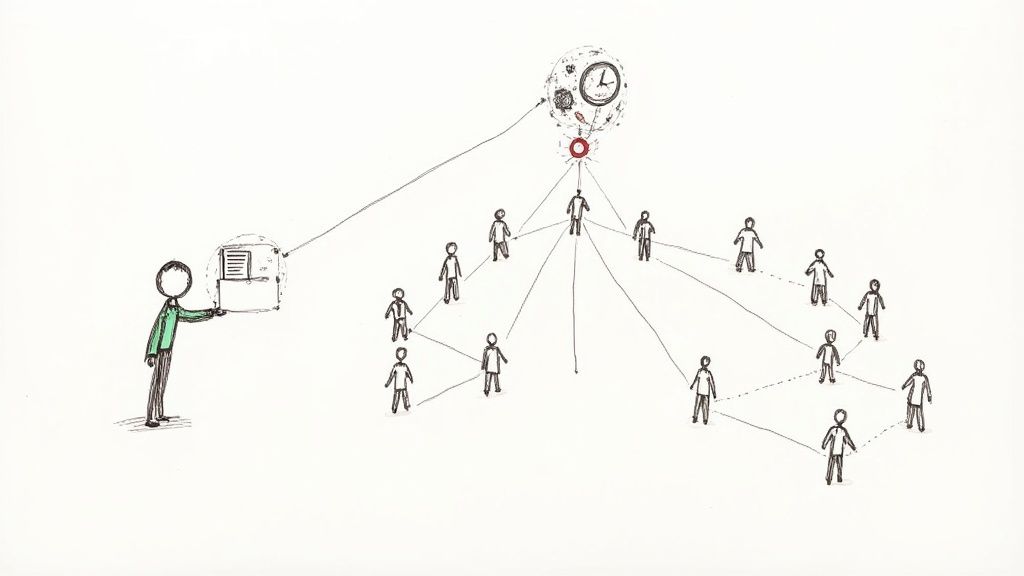How to Manage Multiple Projects Like a Founder
Discover proven strategies on how to manage multiple projects with ease. Prioritize, delegate, and optimize workflows to succeed today!
Oct 12, 2025

Let's get one thing straight. The real secret to managing multiple projects isn’t about juggling—it's about building a machine. Juggling is for clowns at the circus; it’s a frantic, reactive state where you're one slip-up away from total collapse. It’s a recipe for burnout, not a blueprint for building an empire.
The most effective people I know—startup founders, billionaires, productivity savants like Tim Ferriss—don’t juggle. They don't work harder; they design better systems. They think from first principles to remove themselves as the bottleneck. They become orchestrators, not jugglers. This isn't just semantics. It's a fundamental mental model shift from frantic activity to strategic, leveraged output.
The Mental Shift: From Juggling to Orchestrating

You cannot be in two places at once. This is a law of physics. The "juggling" metaphor is a trap that glorifies a state of constant, reactive panic. It’s a one-way ticket to fried adrenal glands and mediocre results. I learned this the hard way building my executive assistant company. My breakthrough didn't come from another espresso shot at 2 AM; it came from tearing down my entire approach to work and rebuilding it from the ground up.
Deconstructing the Problem from First Principles
The core problem isn't the number of projects. It's the cognitive load from disorganized commitments. Your brain treats every "open loop"—every undefined task, fuzzy deadline, or buried email—as a threat. This constant, low-grade anxiety is the psychic weight that makes juggling feel so impossible.
To escape this cycle, you need a new mental model. Think of yourself as the architect of a system, not a worker within it. The architect doesn't lay every brick. They design the blueprint, specify the materials, and ensure the foundation is solid so the skyscraper can be built.
The goal is to design a system where progress happens without your direct, moment-to-moment involvement. It’s about creating leverage, not just managing tasks.
This guide is my blueprint for reframing how to manage multiple projects. We're going to deconstruct the problem and apply first-principles thinking to build a system that runs itself.
Forget juggling. It's time to build your machine.
Build Your Single Source of Truth
Complexity is the enemy of execution. If your project data is scattered across emails, Slack DMs, Google Docs, and sticky notes, you don't have a system—you have a digital junk drawer. This isn't just inefficient; it's fatal. High-velocity founders like Jeff Bezos obsess over creating systems that reduce friction. A scattered information landscape is pure friction.
Your first move is to forge a Single Source of Truth (SSOT). This isn't about picking a shiny tool like Asana or Notion. It's a philosophical commitment: if it's not in the SSOT, it doesn't exist. Period. This is non-negotiable.
Why Centralization Is a First Principle
A fragmented system forces your brain to context-switch, burning precious glucose just to find the information you need to make a decision. Every minute you spend hunting for a file is a minute you're not spending on the high-leverage work that actually grows the business. High-growth founders cannot afford this tax.
This isn't just my opinion. The data shows it's a fundamental shift in how elite teams operate. A staggering 82% of organizations now use project management software, and the market is projected to hit $12.02 billion by 2030. This isn't a trend; it's the new operating standard. You can dive deeper into the top project management statistics for 2025 to see the raw numbers.
Your SSOT is not a passive database. It's an active, forward-looking command center. It must provide a 10,000-foot view that allows for instantaneous pattern recognition of bottlenecks and opportunities.
This simple infographic nails the journey from chaos to clarity.

The process is a forcing function: centralize all inputs, process them through a standardized system, and generate clear, actionable outputs.
Designing Your Command Center
Your command center should be ruthlessly minimalist. I've reverse-engineered the systems of top VCs and founders—they are allergic to vanity metrics. They only track what drives decisions.
For your dashboard to be effective, every project must have these non-negotiable data points.
Essential Components of a Unified Dashboard
A first-principles breakdown of the minimum effective dose of information for project orchestration.
Component | Description | Why It's Critical |
|---|---|---|
Project Name | A clear, concise identifier for the initiative. | Eliminates ambiguity. Creates a shared language for the team. |
Project Owner | The one person ultimately accountable for the outcome. | The "single wringable neck." Diffused responsibility is a recipe for failure. |
Status | A simple tag like On Track, At Risk, or Blocked. | Enables rapid triage. Allows you to scan and identify fires in under 5 seconds. |
Next Action | The single most important physical action to move the project forward. | Kills procrastination. Converts abstract goals into concrete, immediate tasks. |
Due Date | The deadline for that specific Next Action. | Creates short-term accountability and forces a rhythm of execution. |
With these five columns, you can get a complete operational picture in 60 seconds. This isn't micromanagement; it's designing a system for radical clarity that frees you to think strategically.
Apply Ruthless Prioritization Daily

Let's be brutally honest: "busy" is a form of laziness. It's easy to fill your day with low-impact tasks that feel productive. The hard work is in the thinking—the ruthless, analytical process of identifying the vital few activities that create disproportionate results.
The Pareto Principle, or 80/20 rule, isn't just a clever aphorism; it's a law of nature. Roughly 80% of outcomes stem from 20% of inputs. Most people nod along to this, then immediately go back to their bloated to-do list, treating every item as equal. The most effective founders I know live and die by this principle. It is the operating system for their attention.
Go Beyond Basic Prioritization
The classic Eisenhower Matrix (Urgent/Important) is a good starting point, but it's too binary for the complex, probabilistic world of a founder. A project can be important, but if the probability of success is near zero, is it really the best use of capital?
This is why I use a weighted scoring model. It forces objectivity and removes emotion from the equation. It's a mental model for capital allocation—and your time is your most valuable capital. You can explore the philosophy in our guide to executive time management, but here’s the core algorithm.
Run every significant initiative through this filter:
Impact (Score 1-10): If this works, how significantly does it move the needle on our primary goal (e.g., revenue, user growth)? A 10 is a game-changer.
Confidence (Score 1-10): How high is our degree of certainty that we can execute this successfully and achieve the desired outcome? This is where you inject realism.
Ease (Score 1-10): How much time, energy, and resources will this consume? A 10 is a quick, low-effort win. A 1 is a multi-year slog.
The formula is simple: Impact x Confidence x Ease = Priority Score.
Making the Hard Choices
Once you score your projects, the path becomes starkly clear. That shiny pet project you love might score a 50. That "boring" but critical infrastructure update you've been avoiding scores a 700. The math doesn't have feelings. Trust the math.
This system isn't about finding a perfect number. It's a thinking tool that forces an honest, first-principles evaluation of your choices. It makes the opportunity cost of working on low-scoring items painfully obvious.
Your most valuable, non-renewable asset is focused attention. A ruthless prioritization framework isn't about being robotic; it's about being a fierce guardian of that asset, directing it only toward what truly matters.
When you apply this model daily, you stop being a victim of your inbox and start becoming the architect of your outcomes. This is the single most powerful habit for anyone trying to figure out how to manage multiple projects.
Master Asynchronous Communication
Real-time is a trap. If your day is a series of back-to-back meetings and "quick syncs," you are not a knowledge worker; you are a human interrupt-request handler. This is why founders like Jason Fried of Basecamp are so allergic to meetings. They understand that deep work, the kind that creates real value, is impossible in 30-minute slivers. The solution is to default to asynchronous communication.
This means engineering your communication—an email, a project brief, a task delegation—to be so clear and self-contained that it obviates the need for a follow-up conversation. You provide all the context upfront, empowering your team to execute without waiting for you. It's a system built on mutual respect for each other's focus.
Embrace the Brief-Back Method
One of the most powerful mental models for this is the "Brief-Back," adapted from elite military units. After a mission commander outlines a plan, a soldier is required to repeat the core objectives back in their own words. It's not a test of memory; it's a test of clarity. If the brief-back is fuzzy, the initial brief was a failure.
I use this for every meaningful delegation:
The Brief: I craft a single, comprehensive message. It covers the what (the desired outcome), the why (the strategic context), and any critical constraints or resources. All necessary links are embedded.
The Brief-Back Request: I explicitly ask my Executive Assistant or team lead to summarize the objective and their proposed first step back to me.
The Greenlight: I do not give the green light until their brief-back demonstrates 100% comprehension.
This three-step process feels slower at first, but it eliminates 90% of the downstream friction and rework that plagues most projects. It's an upfront investment in clarity that pays massive dividends in speed and accuracy.
The goal of your communication is to pre-emptively answer the next three questions. This level of engineered clarity is a superpower when you need to manage multiple projects.
This is where a world-class executive assistant becomes an invaluable force multiplier. They are the hub of your asynchronous system, filtering noise and ensuring every piece of communication that reaches you is clear and actionable. My EA, for example, translates chaotic email threads into concise, decision-ready briefs.
Building this communication OS is a game-changer. Our guide on virtual assistant email management deconstructs the exact process. By mastering asynchronous workflows, you're not just being more efficient; you're building a scalable operating system for your entire organization.
Leverage Through Radical Delegation

Here's a first principle every successful founder, from Tim Ferriss to Naval Ravikant, internalizes: you cannot scale yourself. The attempt to do so makes you the primary constraint on your own growth. The answer is not just delegation; it’s a mental model of radical leverage.
This isn't about offloading tasks you dislike. It's a strategic acquisition of time, which you then reinvest into the handful of activities where you have unique leverage—the things only you can do. Real leverage comes from building systems and empowering people to execute flawlessly within them, often better and faster than you could.
Identifying What to Delegate First
The novice delegates randomly. The pro delegates systematically. You need a mental model for identifying high-leverage delegation opportunities.
Start by auditing your time and bucketing tasks into these three categories for immediate offloading:
Repetitive Tasks: Anything you do on a recurring basis that follows a script. Filtering your inbox, generating weekly reports, scheduling meetings. These are the easiest to systemize and delegate because they are predictable.
Teachable Tasks: Work that requires judgment but can be taught through clear principles and instructions. Conducting initial market research, vetting vendors, managing your CRM. If you can create a decision-making framework for it, you can delegate it.
Tasks Outside Your Zone of Genius: This requires brutal self-awareness. Are you truly the best person in the world to be doing your own bookkeeping, designing social media graphics, or troubleshooting IT issues? Every minute spent on a task where you are not world-class is an act of theft from the activities where you are.
Building a System for Flawless Execution
Delegation without a system is abdication. It's hope as a strategy. The goal is to build a machine that produces a consistent, high-quality output regardless of the operator. The tool for this is the Standard Operating Procedure (SOP).
An SOP is more than a checklist. It is the physical manifestation of your knowledge. It codifies best practices, turning your expertise into a scalable, repeatable asset.
Creating an SOP is simple. Use a tool like Loom to record your screen while you perform the task. Narrate your process out loud, explaining the why behind each click. This video becomes the master template.
Your executive assistant then uses this recording to build a written, step-by-step guide with screenshots. This process is its own training, forcing them to deconstruct and internalize the task completely.
Mastering how to delegate tasks effectively isn't a soft skill; it's a core competency. It's the mechanism by which you transition from doer to architect, and it is the only sustainable way to manage multiple projects and scale your impact.
Answering Your Toughest Project Management Questions
No system is perfect. The robustness of a system isn't measured when things are calm, but when chaos hits. It’s about building a framework that is antifragile—one that gets stronger under stress. Let's address the common failure points I see when founders try to implement these models.
This isn't about avoiding problems; it's about having a pre-designed response for when they inevitably arise.
What Do I Do When an "Urgent" Task Wrecks My Plan?
First, let's deconstruct the word "urgent." As productivity thinkers like Tim Ferriss have drilled into us, someone else's urgency is not your emergency. A lack of planning on their part does not constitute a crisis on yours. Your default response should not be to react, but to process.
When an "urgent" request hits, run it through the same ruthless prioritization filter:
Impact: Does this truly serve a primary company objective?
Confidence: Do we have a clear definition of "done" and a high probability of success?
Ease: What is the true cost in time and resources?
If, after this objective analysis, the task scores high and has a legitimate, immovable deadline, then your system has worked. It has identified a true priority. You can then make a conscious, strategic decision to reshuffle resources. But you'll find that 90% of the time, these "urgent" tasks are just noise. They get scored, prioritized, and placed into the system accordingly, protecting your focus for the deep work that matters.
The purpose of your system is not to create a rigid plan that never changes. It's to provide the clarity needed to make intelligent trade-offs when reality inevitably intervenes.
I'm a Solo Founder with No Team. Where Do I Even Start?
The solo founder's trap is thinking you need to hire people to get leverage. This is backward. First, you hire systems. Your first and most critical "hire" is your Single Source of Truth.
Getting every commitment, idea, and task out of your head and into an external, trusted system is the highest-leverage action you can take. It immediately reduces cognitive load and forces you to operate like a CEO, not just an employee of one.
Once your SSOT is built, your sole focus should be on generating enough revenue or freeing up enough time to afford your first real leverage point. Don't think full-time. Think in micro-slices. A virtual assistant for just five hours a week is a force multiplier that will fundamentally change the physics of your business.
How Often Should I Be Reviewing My Projects?
You need a multi-level review cadence, like a pilot scanning different instruments at different altitudes. A single review process is insufficient for navigating both day-to-day execution and long-term strategy.
I've pressure-tested this and found a two-tier system to be universally effective:
The Weekly Tactical Review: This is a non-negotiable 30-minute block every Friday. This is your ground-level check. You review your SSOT. Did we do what we said we would do? What are the key priorities for next week? This is for short-cycle course correction and maintaining momentum.
The Monthly/Quarterly Strategy Session: This is your 30,000-foot view. You zoom out and ask the hard, first-principles questions. Is this project still the highest-leverage use of our resources? Based on new data, should we kill, pivot, or double down? This is where you make the big-bet decisions that define your trajectory.
Ready to stop juggling and start orchestrating? At Hyperon, we connect you with the top 1% of executive assistants who are experts in building and managing these systems, so you can focus on what you do best. Learn how Hyperon can help you scale faster.